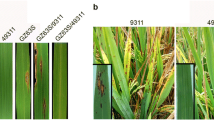Abstract
R917, a japonica rice mutant with broad-spectrum of resistance to blast, was selected after treatment of the F1 seeds from the cross between Chengte 232 and Xiushui 37 with 10 krad of 60Co γ-ray. R917 was evaluated for blast resistance in multiple years and locations. It was resistant to 136 of 138 strains of Magnaporthe grisea collected from different regions in China with a resistance frequency of 98.55%, much higher than 86.13% and 10.15% of Chengte 232 and Xiushui 37. To analyze its inheritance of resistance to blast, R917 was crossed with the susceptible cultivar, Nonghu 6, and its two parents. It had a single dominant resistance gene to Chinese races ZB13, ZC15 and ZE3, nonallelic to those of Chengte 232 and Xiushui 37. When inoculated with 7 Japanese differential strains, R917 showed the same reaction pattern as Toride 1 and differed from the other differential varieties. But R917 was different from Toride 1 in its reaction to 7 Chinese strains. Allelism test indicated that the resistance genes between R917 and Toride 1 were nonallelic to Chinese races ZC15 and ZE3. R917 was a semi dwarf with strong stem, narrow and erect leaf, tight plant type and monogenic broad-spectrum resistance to blast. Several lines with desirable agronomic traits newly bred using R917 as a donor of blast resistance had the same broad-spectrum of resistance to blast as R917, indicating there was no linkage drag between the resistance gene and other important agronomic genes in R917. R917 has been used as a donor in rice breeding programs in China.
Similar content being viewed by others
References
Bonman, J.M., T.I.Vergel, D.E. Dios & M.M. Khin, 1986. Physiological specialization of Pyricularia oryzae in the Philippines. Plant Dis 70: 767-769.
Ikehashi, I. & G.S. Khush, 1979. Breeding for blast resistance at IRRI. In: International Rice Research Institute (Ed.), Proceedings of the Rice Blast Workshop, pp. 220, 21 to 23 Febrary. International Rice Research Institute, Los Banos, Philippines.
International Rice Research Institute, 1988. Standard Evaluation System for Rice. Los Banos, Manila, Philippines, 52 pp.
Kiyosawa, S., 1972. Genetics of blast resistance. In: International Rice Research Institute (Ed.), Rice Breeding, pp. 203-225. International Rice Research Institute, Los Banos, Manila, Philippines.
Konzak, C.F., R.A. Nilan & A. Kleinhofs, 1977. Artificial mutagenesis as an aid in overcoming genetic vulnerability of crop plants. In: A. Muhammed, R. Aksel & R.C. Borstel (Eds.), Genetic Diversity in Plants, pp. 163-177. New York and London, Plenum Press.
Krull, C.F. & K.J. Frey, 1961. Genetic variability in oats following hybridization and radiation. Crop Sci 1: 141-146.
Li, H.W., C.H. Hu & H.P. Wu, 1968. Induced mutation breeding of rice in the Republic of China. In: International Atomic Energy Agency (Ed.), Rice Breeding with Induced Mutations, Tech. Rep. Ser. No. 86, pp. 17-24. International Atomic Energy Agency, Viena, Austria.
Marie, R. & A. Tinarelli, 1972. Rice mutants and resistance to blast disease. Riso 21: 21-24.
Mikaelsen, K., Z. Saja & J. Simon, 1971. An early maturing mutant: its value in breeding for disease resistance in rice. In: International Atomic Energy Agency (Ed.), Rice Breeding with Induced Mutations, Tech. Rep. Ser. No. 131, pp. 97-101. International Atomic Energy Agency, Viena, Austria.
Ou, S.H., 1979. Breeding rice for resistance to blast, A critical view. In: International Rice Research Institute (Ed.), Proceedings of the Rice Blast Workshop, pp. 79-137, 21-23 February. International Rice Research Institute, Los Banos, Philippines.
Ou, S.H., 1985. Rice disease. Commonwealth Mycological Institute, The Cambrian News Ltd.
Wang, L.Q., W.Q. Zhang, Q.X. Fan & P.X. Shi, 1980. Investigation on improving efficiency for mutation breeding of winter wheat by the combined use of radiation and hybridization. ACTA AGRONOMICA SINICA 6(4): 237-244.
Xu, J.L., Y.Z. Lin & Y.A. Xi, 1994. Analysis of resistance gene of Chengte 232 to rice blast. Acta Phytophylacica Sinica 21(1): 63-66.
Yamasaki, Y. & T. Kawai, 1968. Artificial induction of blastresistant mutations in rice. In: International Atomic Energy Agency (Ed.), Rice Breeding with Induced Mutations. Tech. Rep. Ser. No. 86, pp. 17-24. International Atomic Energy Agency, Viena, Austria.
Author information
Authors and Affiliations
Rights and permissions
About this article
Cite this article
Zhang, M.X., Xu, J.L., Luo, R.T. et al. Genetic analysis and breeding use of blast resistance in a japonica rice mutant R917. Euphytica 130, 71–76 (2003). https://doi.org/10.1023/A:1022380626371
Issue Date:
DOI: https://doi.org/10.1023/A:1022380626371




